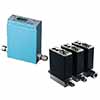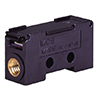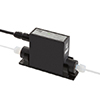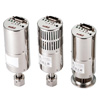Microelectromechanical Systems (MEMS)
MEMS refers to ultra-compact devices or systems which integrate mechanical components like sensors and electronic circuits on a substrate such as silicon by applying microfabrication techniques based on the technology used in semiconductor manufacturing. MEMS are used to miniaturize equipment, save power, achieve high functionality, and reduce cost.
- A variety of MEMS are at work inside various devices
- Born of microfabrication technology utilized in semiconductor manufacturing

A variety of MEMS are at work inside various devices
Smartphones are now an indispensable tool for our daily lives. Making a phone call, getting various types of information from the Internet, enjoying music, movies, and games, and knowing where you are---life without a smartphone is now difficult to imagine.
It is thanks to microelectromechanical systems inside the case of the smart phone that it can provide such a variety of functions. Since MEMS refers to various devices or systems such as sensors that incorporate microscopic electrical and mechanical elements on one chip, they are sometimes called microsystems or micromachines.
Taking smartphone functions as an example, magnetic sensors and pressure sensors are used in addition to GPS sensors to detect location, and an accelerometer is used for the function that rotates the screen automatically when the orientation of the smartphone is changed. Also, an ambient light sensor automatically adjusts the screen brightness according to the amount of light in the environment. In addition to these sensors, devices such as ultra-small microphones and speakers built into smartphones are also a type of MEMS.
Of course, the smartphones mentioned here are just one example of MEMS-incorporated products. MEMS are built into a wide range of devices such as automobiles, printers, video equipment, health-related equipment and other consumer products, air conditioning equipment used in office buildings, manufacturing equipment operating in factories, etc. They make an enormous contribution to people’s lives and to industrial activity in virtually every situation.
Born of microfabrication technology utilized in semiconductor manufacturing
Generally in MEMS, electrical elements and mechanical elements---specifically sensors, actuators, and electronic circuits---are integrated on one chip. Various microfabrication and laser processing technologies used in semiconductor manufacturing have played an important role in the development of MEMS up to this point.
For example, so far semiconductor integrated circuits have had a two-dimensional structure, and to manufacture them for improved performance and reduced power consumption, the circuit line width has been progressively reduced in order to fit more transistors into smaller circuits. As a result, microfabrication technology on the order of a micrometer (1 millionth of a meter) has been realized, making it possible to create MEMS with a three-dimensional structure with complex and advanced me chanical properties.
Also, the silicon chip itself, which has been used in semiconductor integrated circuits, has also become an important element for making MEMS. Normally, extremely high-purity silicon with a single-crystal structure is used for semiconductors. Silicon crystals are much more stable than other material such as iron, and they are suitable for controlling electrical characteristics. In addition, silicon is easy to process in three dimensions, which is a great advantage for MEMS manufacturing. The presence of silicon, which is an excellent substrate material, is one of the driving forces behind the in vention of microelectromechanical systems and their subsequent development.
In addition to silicon, materials such as sapphire, ceramics, and glass have been used as the substrate for MEMS. For example, since sapphire has excellent heat and corrosion resistance, it is used in the MEMS incorporated into in dustrial equipment, and its expanded use for various applications can be expected.
Various devices that add color to your life, such as smartphones, automobiles, and home appliances, have been developing at an accelerating pace against the backdrop of digital technology innovation, providing us with new value such as greater convenience, comfort, and enjoyment. This kind of progress is possible thanks to the existence of MEMS working quietly inside digital devices. As a kind of “unsung hero,” microelectromechanical systems, which contribute to our daily lives and social activities, are continuing to shrink in size. We are really looking forward to what the future holds!









